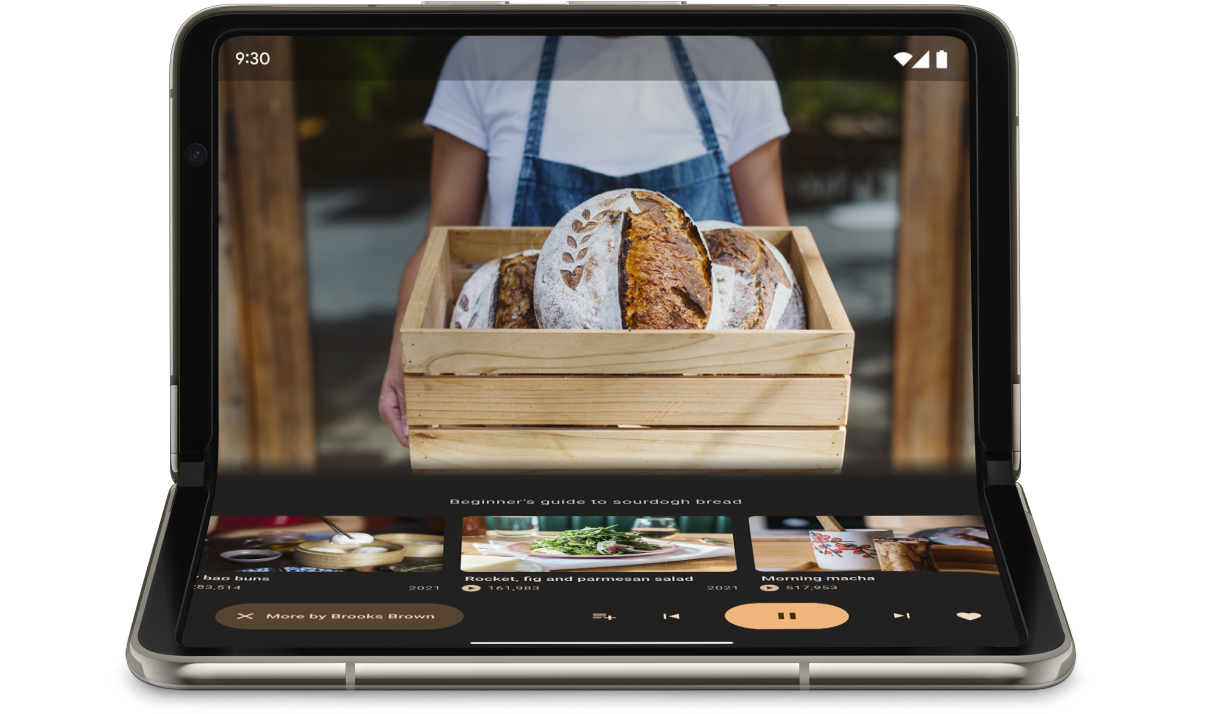借助展开的大显示屏和独特的折叠状态,我们能够在可折叠设备上打造全新用户体验。如需让应用具备折叠感知能力,请使用 Jetpack WindowManager 库,它为可折叠设备的窗口功能(如折叠边或合页)提供了一个 API surface。如果应用具备折叠感知能力,就能调整其布局,避免将重要内容放在折叠边或合页区域,并将折叠边或合页用作自然分隔符。
了解设备是否支持桌面或图书姿态等配置,有助于决定是否支持不同的布局或提供特定功能。
窗口信息
Jetpack WindowManager 中的 WindowInfoTracker 接口会公开窗口布局信息。该接口的 windowLayoutInfo() 方法会返回一个 WindowLayoutInfo 数据流,该数据流会将可折叠设备的折叠状态告知您的应用。WindowInfoTracker#getOrCreate() 方法会创建 WindowInfoTracker 的实例。
WindowManager 支持通过 Kotlin Flow 和 Java 回调收集 WindowLayoutInfo 数据。
Kotlin 数据流
如需开始和停止 WindowLayoutInfo 数据收集,您可以使用可重启的生命周期感知型协程。采用这种方式,当生命周期至少为 STARTED 时,系统会执行 repeatOnLifecycle 代码块,当生命周期为 STOPPED 时,将会停止执行该代码块。当生命周期再次为 STARTED 时,系统会自动重新开始执行该代码块。在以下示例中,该代码块会收集并使用 WindowLayoutInfo 数据:
class DisplayFeaturesActivity : AppCompatActivity() {
private lateinit var binding: ActivityDisplayFeaturesBinding
override fun onCreate(savedInstanceState: Bundle?) {
super.onCreate(savedInstanceState)
binding = ActivityDisplayFeaturesBinding.inflate(layoutInflater)
setContentView(binding.root)
lifecycleScope.launch(Dispatchers.Main) {
lifecycle.repeatOnLifecycle(Lifecycle.State.STARTED) {
WindowInfoTracker.getOrCreate(this@DisplayFeaturesActivity)
.windowLayoutInfo(this@DisplayFeaturesActivity)
.collect { newLayoutInfo ->
// Use newLayoutInfo to update the layout.
}
}
}
}
}
Java 回调
借助 androidx.window:window-java 依赖项中包含的回调兼容性层,您无需使用 Kotlin Flow 即可收集 WindowLayoutInfo 更新。该制品包含 WindowInfoTrackerCallbackAdapter 类,该类会调整 WindowInfoTracker 来支持注册(和取消注册)用于接收 WindowLayoutInfo 更新的回调,例如:
public class SplitLayoutActivity extends AppCompatActivity {
private WindowInfoTrackerCallbackAdapter windowInfoTracker;
private ActivitySplitLayoutBinding binding;
private final LayoutStateChangeCallback layoutStateChangeCallback =
new LayoutStateChangeCallback();
@Override
protected void onCreate(@Nullable Bundle savedInstanceState) {
super.onCreate(savedInstanceState);
binding = ActivitySplitLayoutBinding.inflate(getLayoutInflater());
setContentView(binding.getRoot());
windowInfoTracker =
new WindowInfoTrackerCallbackAdapter(WindowInfoTracker.getOrCreate(this));
}
@Override
protected void onStart() {
super.onStart();
windowInfoTracker.addWindowLayoutInfoListener(
this, Runnable::run, layoutStateChangeCallback);
}
@Override
protected void onStop() {
super.onStop();
windowInfoTracker
.removeWindowLayoutInfoListener(layoutStateChangeCallback);
}
class LayoutStateChangeCallback implements Consumer<WindowLayoutInfo> {
@Override
public void accept(WindowLayoutInfo newLayoutInfo) {
SplitLayoutActivity.this.runOnUiThread( () -> {
// Use newLayoutInfo to update the layout.
});
}
}
}
RxJava 支持
如果您已在使用 RxJava(版本 2 或 3),则可以通过工件来使用 Observable 或 Flowable 收集 WindowLayoutInfo 更新,而无需使用 Kotlin Flow。
androidx.window:window-rxjava2 和 androidx.window:window-rxjava3 依赖项提供的兼容性层包含 WindowInfoTracker#windowLayoutInfoFlowable() 和 WindowInfoTracker#windowLayoutInfoObservable() 方法,使您的应用能够接收 WindowLayoutInfo 更新,例如:
class RxActivity: AppCompatActivity {
private lateinit var binding: ActivityRxBinding
private var disposable: Disposable? = null
private lateinit var observable: Observable<WindowLayoutInfo>
@Override
protected void onCreate(@Nullable Bundle savedInstanceState) {
super.onCreate(savedInstanceState);
binding = ActivitySplitLayoutBinding.inflate(getLayoutInflater());
setContentView(binding.getRoot());
// Create a new observable.
observable = WindowInfoTracker.getOrCreate(this@RxActivity)
.windowLayoutInfoObservable(this@RxActivity)
}
@Override
protected void onStart() {
super.onStart();
// Subscribe to receive WindowLayoutInfo updates.
disposable?.dispose()
disposable = observable
.observeOn(AndroidSchedulers.mainThread())
.subscribe { newLayoutInfo ->
// Use newLayoutInfo to update the layout.
}
}
@Override
protected void onStop() {
super.onStop();
// Dispose of the WindowLayoutInfo observable.
disposable?.dispose()
}
}
可折叠设备显示屏的功能
Jetpack WindowManager 的 WindowLayoutInfo 类会以 DisplayFeature 元素列表的形式提供显示窗口的功能。
FoldingFeature 是一种 DisplayFeature,它提供了有关可折叠设备显示屏的信息,其中包括以下属性:
state:设备的折叠状态,即FLAT或HALF_OPENEDorientation:折叠边或铰链的方向,即HORIZONTAL或VERTICALisSeparating:折叠边或铰链是否创建了两个逻辑显示区域,即 true 或 false
HALF_OPENED 的可折叠设备始终将 isSeparating 报告为 true,因为屏幕被分为两个显示区域。此外,当应用跨两块屏幕时,isSeparating 在双屏设备上始终为 true。
FoldingFeature bounds 属性(继承自 DisplayFeature)表示折叠功能的边界矩形(如折叠边或铰链)。可以使用边界将元素放到与功能相关的屏幕上:
Kotlin
override fun onCreate(savedInstanceState: Bundle?) {
// ...
lifecycleScope.launch(Dispatchers.Main) {
lifecycle.repeatOnLifecycle(Lifecycle.State.STARTED) {
// Safely collects from WindowInfoTracker when the lifecycle is
// STARTED and stops collection when the lifecycle is STOPPED.
WindowInfoTracker.getOrCreate(this@MainActivity)
.windowLayoutInfo(this@MainActivity)
.collect { layoutInfo ->
// New posture information.
val foldingFeature = layoutInfo.displayFeatures
.filterIsInstance<FoldingFeature>()
.firstOrNull()
// Use information from the foldingFeature object.
}
}
}
}
Java
private WindowInfoTrackerCallbackAdapter windowInfoTracker;
private final LayoutStateChangeCallback layoutStateChangeCallback =
new LayoutStateChangeCallback();
@Override
protected void onCreate(@Nullable Bundle savedInstanceState) {
// ...
windowInfoTracker =
new WindowInfoTrackerCallbackAdapter(WindowInfoTracker.getOrCreate(this));
}
@Override
protected void onStart() {
super.onStart();
windowInfoTracker.addWindowLayoutInfoListener(
this, Runnable::run, layoutStateChangeCallback);
}
@Override
protected void onStop() {
super.onStop();
windowInfoTracker.removeWindowLayoutInfoListener(layoutStateChangeCallback);
}
class LayoutStateChangeCallback implements Consumer<WindowLayoutInfo> {
@Override
public void accept(WindowLayoutInfo newLayoutInfo) {
// Use newLayoutInfo to update the Layout.
List<DisplayFeature> displayFeatures = newLayoutInfo.getDisplayFeatures();
for (DisplayFeature feature : displayFeatures) {
if (feature instanceof FoldingFeature) {
// Use information from the feature object.
}
}
}
}
桌面姿态
利用 FoldingFeature 对象中包含的信息,您的应用可以支持桌上模式等折叠状态。在这种模式下,手机置于平面上、铰链处于水平位置,可折叠屏幕处于半开状态。
桌面姿势让用户无需拿着手机就能轻松操作手机。桌面姿势适合在观看媒体内容、拍照和进行视频通话时使用。

您可以使用 FoldingFeature.State 和 FoldingFeature.Orientation 确定设备是否处于桌面模式:
Kotlin
fun isTableTopPosture(foldFeature : FoldingFeature?) : Boolean {
contract { returns(true) implies (foldFeature != null) }
return foldFeature?.state == FoldingFeature.State.HALF_OPENED &&
foldFeature.orientation == FoldingFeature.Orientation.HORIZONTAL
}
Java
boolean isTableTopPosture(FoldingFeature foldFeature) {
return (foldFeature != null) &&
(foldFeature.getState() == FoldingFeature.State.HALF_OPENED) &&
(foldFeature.getOrientation() == FoldingFeature.Orientation.HORIZONTAL);
}
确定设备处于桌面模式后,应相应地更新应用布局。对于媒体应用,这通常意味着将播放媒体置于折线上方,控件和补充内容置于下方,从而提供免触摸观看或收听体验。
在 Android 15(API 级别 35)及更高版本中,您可以调用同步 API 来检测设备是否支持桌面姿态,无论设备处于何种状态。
该 API 提供设备支持的姿势列表。如果该列表包含桌面姿态,您可以拆分应用布局以支持该姿态,并针对桌面布局和全屏布局对应用界面运行 A/B 测试。
Kotlin
if (WindowSdkExtensions.getInstance().extensionsVersion >= 6) {
val postures = WindowInfoTracker.getOrCreate(context).supportedPostures
if (postures.contains(TABLE_TOP)) {
// Device supports tabletop posture.
}
}
Java
if (WindowSdkExtensions.getInstance().getExtensionVersion() >= 6) {
List<SupportedPosture> postures = WindowInfoTracker.getOrCreate(context).getSupportedPostures();
if (postures.contains(SupportedPosture.TABLETOP)) {
// Device supports tabletop posture.
}
}
示例
MediaPlayerActivity应用:了解如何使用 Media3 Exoplayer 和 WindowManager 创建具备折叠感知能力的视频播放器。使用 Jetpack WindowManager 优化可折叠设备上的相机应用 Codelab:了解如何为摄影应用实现桌面姿态。在屏幕的上半部分(折线上方)显示取景器,在下半部分(折线下方)显示控件。
图书模式
可折叠设备的另一种独特的折叠状态是图书模式。在这种模式下,设备处于半开状态,并且铰链是垂直的。图书模式非常适合阅读电子书。在可像装订版书籍一样打开的大屏可折叠设备上,图书姿势会采用双页布局,为您带来如同阅读纸质图书一般的体验。
如果您想在免触摸拍照时以不同的宽高比拍摄照片,也可以使用该模式进行摄影。
您可以采用与桌面姿势相同的技术实现图书姿势。唯一的不同之处是代码应检查折叠功能应用的屏幕方向是否为垂直,而非水平:
Kotlin
fun isBookPosture(foldFeature : FoldingFeature?) : Boolean {
contract { returns(true) implies (foldFeature != null) }
return foldFeature?.state == FoldingFeature.State.HALF_OPENED &&
foldFeature.orientation == FoldingFeature.Orientation.VERTICAL
}
Java
boolean isBookPosture(FoldingFeature foldFeature) {
return (foldFeature != null) &&
(foldFeature.getState() == FoldingFeature.State.HALF_OPENED) &&
(foldFeature.getOrientation() == FoldingFeature.Orientation.VERTICAL);
}
窗口大小变化
应用的显示区域可能会因设备配置变更(例如设备折叠或展开、旋转,或窗口在多窗口模式下调整大小)而发生变化。
借助 Jetpack WindowManager 的 WindowMetricsCalculator 类,您可以检索当前和最大窗口指标。与 API 级别 30 中引入的平台 WindowMetrics 一样,WindowManager
WindowMetrics 会提供窗口边界,不过 API 可向后兼容到 API 级别 14。
请参阅使用窗口大小类别。
其他资源
示例
- Jetpack WindowManager:如何使用 Jetpack WindowManager 库的示例
- Jetcaster:使用 Compose 实现桌面模式
